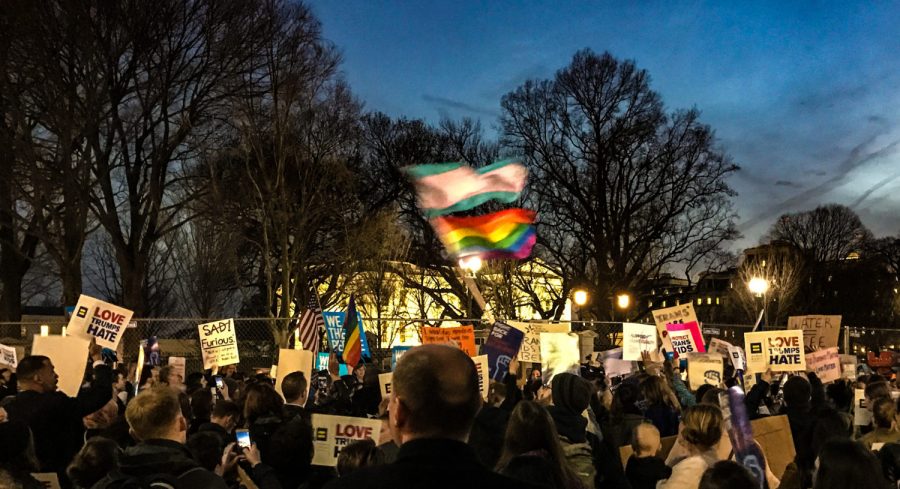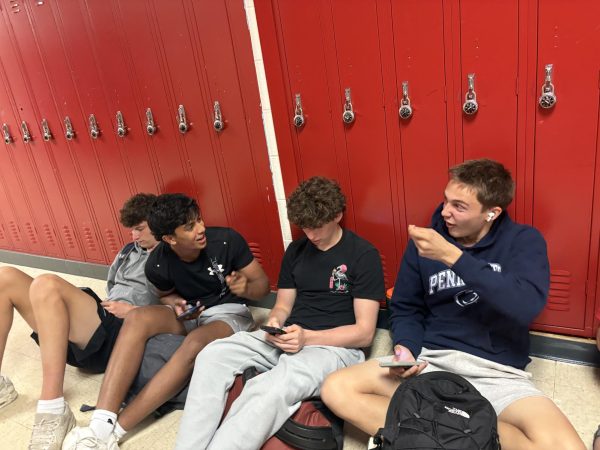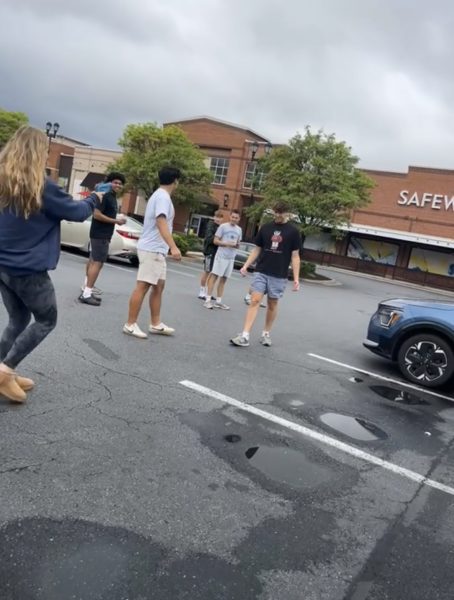Then and now: Queer upperclassmen share experiences of acceptance, bigotry at school
Photo used with permission from Google Commons
Activists assemble in front of the White House to protest discrimination against LGBTQ students based on gender identity.
I’d like to preface this article by clarifying that the treatment of queer students at this school is far better than that of most schools. The negative experiences that I and other queer students have had here are not limited to the scope of this school but are experienced in schools across the country.
According to the CDC, 34% of LGBTQ students and 43% of transgender students reported having been bullied on school property, compared to 18% of straight, cisgender students. According to a Child Trends data analysis, only 17 states and D.C. report LGBTQ-inclusive sex-ed curricula in at least half of schools, and according to the Human Rights Campaign 2021 State Equality Index, only 22 states and D.C. had laws in place that addressed harassment and/or bullying of students based on sexual orientation and gender identity. Five states had laws in place that restricted the inclusion of LGBTQ topics in school, and two states had laws in place that prevented school districts from specifically protecting LGBTQ students. The issue of homophobia and transphobia in schools is a systemic issue first and an individual issue second.
That being said, in a poll of 50 Wootton students, 29 (58%) responded that they had witnessed or heard about an incident of homophobia or transphobia occurring among students during their time at this school.
When I started my freshman year in 2019, I was one of a handful of openly trans students at school. The first Maryland court ruling protecting transgender students’ rights to use restrooms and locker rooms in alignment with their gender identity had been passed only a year before.
That year, my identity was rarely recognized or acknowledged by teachers and staff members after being discussed with them. I was frequently excluded, targeted and made the butt of transphobic and homophobic jokes by cis and straight students.
2021 graduate and MC sophomore Nimrod Ravin shared his experiences with homophobia around the same time: “There were a lot of people who were accepting of LGBTQ students, but there were definitely many people who actively harassed and bullied people for their identity. When the harassment happened, I personally saw no one standing against it. There were people who were nominated to homecoming court just as a way to harass them. I think there are pockets of acceptance at the school, but while I was there, I would not say that Wootton was a school that prioritized the safety and acceptance of LGBTQ students.”
Since then, though, the prejudice that I and other queer students have been faced with by students, staff and administration has declined with each passing school year. Two all-gender restrooms were made available to students in 2021, and so far, 12 MCPS high schools have implemented an LGBTQ studies course since its development began in 2020.
“For the most part, there has been a huge improvement. I definitely feel safer this year than I did last year,” senior Lindsey Walter said. “Mr. Nelson’s ‘no tolerance for homophobia’ has really helped, but last year, my friends and I were called slurs a few times.”
While the treatment of queer students is shifting in a more positive direction, it’s still far from perfect. “There are definitely groups of students who are homophobic. Less than before, but still there. People in and near those social circles tend to stay closeted,” Walter said.
When asked if they thought the experiences of queer students at this school differ from those of cis/straight students, Walter said, “I think they do in the sense that queer students are a lot more cautious and less open as they don’t know how people will react. Trans students definitely have it hard because it is very hard to get names and pronouns changed in class rosters. Teachers may be correct, but subs often misgender and deadname students. This is more of a county-wide issue. The student body tends to be good about using correct names and pronouns from what I’ve seen.”
Senior Addy Ziafat says that it’s still hard to feel completely safe as an openly queer student at school: “I was called a slur on the first day of school. And the second. In past years, I’ve even had things thrown at me during lunch. Many students here really make it difficult to see Wootton as a safe place.”
Your donation will support the student journalists of Thomas S. Wootton High School. Your contribution will allow us to purchase equipment and cover our annual website hosting costs.
Senior Isaac Muffett is the opinions editor in his fourth year on the Common Sense staff. When he's not writing or researching, he spends his free time...







